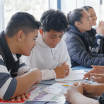Refine and support goal setting
Suggestion for implementing the strategy ‘Planning using UDL in primary settings’
On this page:
On this page:
Current page section: Refine and support goal setting
Go to top of current page: Refine and support goal setting
Go to top of current page: Refine and support goal setting
Go to top of current page: Refine and support goal setting
Purposeful goals
Purposeful goals
Students at Halswell School share their experience of goal setting and monitoring their own progress.
Share goals in multiple ways
Share goals in multiple ways
Students perceive and make sense of infomation differently.
Present goals in multiple ways to support everyone's understanding.
![11724 [visual-prompts.jpeg]](https://inclusive-live-storagestack-assetstorages3bucket-3uty0hejzw6u.s3.ap-southeast-2.amazonaws.com/public/inclusive-education/example-images/visual-prompts__ScaleMaxWidthWzEwODZd.jpeg)
Source: Ministry of Education | Te Tāhuhu o te Mātauranga
Support planning and action
Support planning and action
Suggestions for supporting goal setting and self monitoring
- Provide models or examples of the process.
- Teach students how to plan.
- Provide guides and checklists for scaffolding goal-setting.
- Post goals, objectives, and schedules in an obvious place.
- Involve students in creating what the outcome might look like.
- Break the process up into small steps with visual, video, and verbal supports.
- Offer problem solving checklists.
Explore more practical suggestions on Goalbook Toolkit.
Check for hidden barriers
Check for hidden barriers
Barriers to achivement can be hidden in the way we communicate goals or learning intentions.
Example of an assignment:
Students will be able to write a report about how ways to increase birdlife at school.
This is two tasks in one: write a report and demonstrate understanding about birdlife in the local area.
When setting goals (intentions):
- identify the purpose and make explicit will be assessed
- check for hidden barriers to achievement
- if possible offer students flexible ways to demonstrate understanding
- if a skill such as “write” is included in the goal, ensure supports such as text-to-speech, graphic organisers, word prediction are offered to all students.
Source: Adapted from Goal-based design and the BC curriculum (opens in a new tab/window)
Reflection questions
Reflection questions
Consider these questions for your own context.
- How do I present learning goals and objectives in varied and flexible ways to support engagement and understanding?
- How do I ensure students understand the purpose AND value of an activity?
- How do I make sure students don’t confuse the goal with the means of achieving it?
- How do I offer varied and flexible pathways to success?
Source: Adapted from CAST UDL curriculum self-check (opens in a new tab/window)
Useful resources
Useful resources

Top 10 UDL tips for developing learning goals
A downloadable PDF from CAST with ten tips about learning goals from a UDL perspective
Download PDF
Next steps
More suggestions for implementing the strategy “Design considerations in primary settings”:
Return to the guide “Universal Design for Learning”

How to use this site
Guide to Index of the guide: Universal Design for Learning
Understand:
- Why UDL is valuable
-
Find out about UDLShow suggestions for Find out about UDL
Strategies for action:
-
Design multiple means of EngagementShow suggestions for Design multiple means of Engagement
-
Design multiple means of RepresentationShow suggestions for Design multiple means of Representation
-
Design multiple means of Action and ExpressionShow suggestions for Design multiple means of Action and Expression
-
How to plan using UDLShow suggestions for How to plan using UDL
-
Design considerations in primary settingsShow suggestions for Design considerations in primary settings
-
Design considerations in secondary settingsShow suggestions for Design considerations in secondary settings
-
Design considerations in NCEA assessmentsShow suggestions for Design considerations in NCEA assessments
